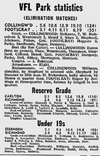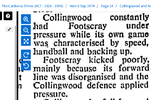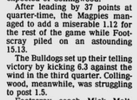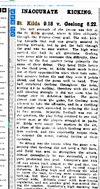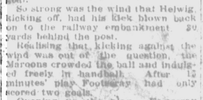- Dec 17, 2006
- 4,403
- 4,680
- AFL Club
- Collingwood

- Other Teams
- South Fremantle, Sturt
- Thread starter
- #951
For some reason i was looking at AFL tables and thought to check out the Pies/Dogs EF in 1974, and i did know the Pies won big that day and the Dogs scored a horribly inaccurate 6.19.55.
What i didn't realise is that in the 1st and 3rd quarters, the Dogs scored 5.1.31, and at the other end, 1.18.24!!
Anyone know if some flukey gale was blowing around at that end? And actually the Pies scored 19.10.124, but in the 2nd and 4th quarters, scored 11.1.67, so that end produced 16.2.98 for the game. The other end..well it was 9.27.81!!
That is rather amazing that one end of VFL park furnishes 2 behinds in a half, the other 27!
That game really is one of the all-time strange ones. Waverley Park was always a very strange venue weather-wise, often wet, windy and cold, and it fully earned its nickname 'Arctic Park' but it's odd that both teams scored freely at both ends, but so accurately at one end, so inaccurately at the other. Windy conditions usually favor one end over another or produce general inaccuracy for both teams all day regardless of which way they are kicking. This clearly didn't happen here with Collingwood and the Dogs.



